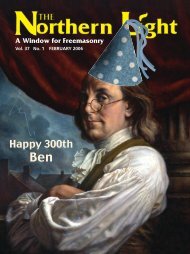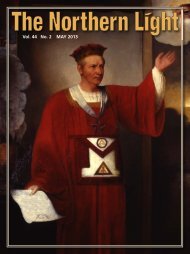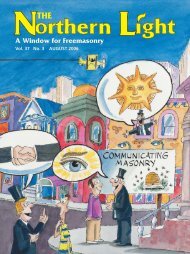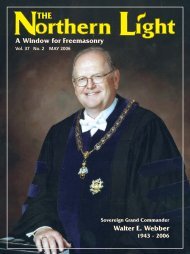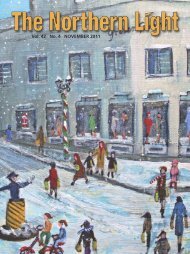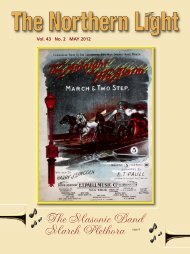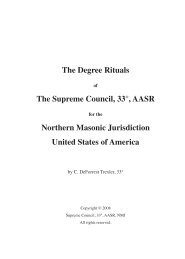May - Scottish Rite
May - Scottish Rite
May - Scottish Rite
You also want an ePaper? Increase the reach of your titles
YUMPU automatically turns print PDFs into web optimized ePapers that Google loves.
for the Finnish Masonic lodges. The resolution was<br />
enthusiastically passed, and Sola informed Sibelius of<br />
the action. The composer graciously accepted.<br />
This enthusiasm also resulted in Suomi Lodge<br />
voting to support the composition project financially.<br />
Lodge member Berndt Forsblom, a pharmacist,<br />
donated 10,000 marks which was promptly paid to<br />
Sibelius.<br />
[Throughout his life]<br />
Sibelius received a number<br />
of Masonic honors from<br />
the United States.<br />
On Jan. 7, 1927, Sibelius met with Sola and other<br />
fraternity Brothers, including Samuli Sario, who<br />
was installed that evening as Master. They read<br />
through some of the selections Sibelius turned out.<br />
Sario, who had exceptional word skills, assisted at<br />
working with the texts, some of which were taken from<br />
such philosophical and mystical writers as Goethe,<br />
Schiller, and even Confucius.<br />
The ritualistic music was completed by Jan. 12, and<br />
the entire work was performed by Sola and organist<br />
Arvi Karvonen for the lodge members that evening.<br />
The Vice Grand Master of Finland, V. M. J.<br />
Viljanen, was in attendance and praised Bro. Sibelius<br />
and his new ritualistic music in a speech claiming it<br />
will make his renown “shine forth and be<br />
immortalized.” The Grand Lodge of Finland was so<br />
delighted with the music that the Grand officers<br />
resolved to make Sibelius an honorary member. He was<br />
the first of the only three Masons to receive that honor.<br />
Sibelius drifted from lodge attendance not long<br />
after the first performance of his Opus 113. He did<br />
attend the tenth anniversary of St. John when a male<br />
quartet sang a vocal rendition of Finlandia with words<br />
by Sola. The arrangement was not actually part of the<br />
ritualistic music, but was sung, at times, after lodge<br />
meetings.<br />
It is interesting to note that Sibelius’ composing the<br />
Opus 113 nearly coincides with the end of his<br />
composing and conducting career. He was supposed to<br />
have written an Eighth Symphony at the urging of<br />
several world renown conductors, including Serge<br />
Koussevitzsky of the Boston Symphony Orchestra, but<br />
it is said he destroyed the score.<br />
Self-doubt and self-criticism haunted Sibelius<br />
throughout his life. The death of his friend Axel<br />
Carpelan affected him terribly, and his drinking<br />
increased during that time. His music was quite the<br />
rage, however, through the 1930’s in both England and<br />
America.<br />
Despite the esteem the British and Americans had<br />
for him, Sibelius never left Finnish soil during the<br />
1930’s. In fact, he became known as “The Silence from<br />
Jarvenpaa.”<br />
Rather surprisingly, in 1946, Sibelius added two<br />
pieces to the ritualistic music collection which<br />
would be his last published music.<br />
An English translation of the Finnish texts was<br />
authorized and published by the Grand Lodge of New<br />
York in 1950.<br />
Although Sibelius virtually abandoned public life,<br />
he was not a total recluse. His five married daughters<br />
and their families occupied much of his time and<br />
interest.<br />
Sibelius received a number of Masonic honors from<br />
the United States, including those on six occasions<br />
from the American Lodge of Research which often<br />
used his music. They elected him a Fellow in 1935.<br />
The Grand Lodge of New York presented him with<br />
the Distinguished Achievement Award in 1938, and in<br />
1950 and 1955, special exhibits in his honor were at<br />
the Grand Lodge Library and Museum for his 85th<br />
and 90th birthdays.<br />
On Sept. 18, 1957, Sibelius had a premonition of<br />
his death as he watched cranes migrating over his<br />
home. Two days later, he suffered a severe stroke. Later<br />
that day, the renown English conductor, Sir Malcolm<br />
Sargent, conducted a performance of the Fifth<br />
Symphony in Helsinki, which would have been<br />
attended by Sibelius family members under normal<br />
circumstances. Brother Jean Sibelius passed on at the<br />
age of 91.<br />
He lay in state in the Helsinki Cathedral, and was<br />
then interred at his beloved estate, Ainola, outside<br />
Jarvenpaa.<br />
Jean Sibelius, the pride of Finland, created many<br />
beautifully inspiring works of music which patriotically<br />
honored his country and musically describe its natural<br />
beauty. He helped to develop the symphonic form as<br />
well as the tone poem. Certainly no less importantly, he<br />
also gave some of the greatest Masonic music to our<br />
fraternity.<br />
The Northern Light / <strong>May</strong> 2010 13<br />
NL




